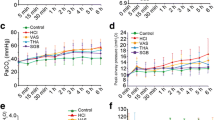Abstract
We investigated the effects of the substance P (SP) blocker [D-Pro2,D-Trp7,9]-SP on the response of rapidly adapting pulmonary stretch receptors (RARs) to SP administered into the right atrium, or ammonia vapor inhaled into the lungs in anesthetized, spontaneously breathing rabbits. Right atrial administration of SP (0.3, 1.0, and 3.0 µg/kg) caused an increase in the RAR activity, and this increase became more prominent as the dose of SP was increased. The RARs increased their activity following inhalation of vapor from 5 and 10% ammonia solutions, and the increase was concentration dependent. The excitatory responses of RAR activity to SP at different doses were greatly diminished or completely blocked by administration of the selective SP antagonist (300 and 500 µg/kg). However, the ammonia-induced RAR stimulation was not significantly altered by prior treatment with the SP blocker (300 and 500 µg/kg). These results suggest that the stimulation of RARs by ammonia does not occur as a result of the release of SP from sensory nerves in the airways and lungs.
Similar content being viewed by others
References
Andersson P, Persson H (1977) Effects of substance P on pulmonary resistance and dynamic pulmonary compliance in the anesthetized cat and guinea pig. Acta Pharmacol Toxicol 41:444–448
Armstrong DJ, Luck JG (1974) A comparative study on irritant and type J receptors in the cat. Respir Physiol 21:47–60
Bergren DR, Sampson SR (1982) Characterization of intra-pulmonary rapidly adapting receptors of guinea pig. Respir Physiol 47:83–95
Das RM, Jeffery PK, Widdicombe JG (1979) Experimental degeneration of intra-epitherial nerve fibers in cat airways. J Anat 128:259–267
Grandordy BM, Frossard N, Rhoden KJ, Barnes PJ (1988) Tachykinin-induced phosphoinositide breakdown in airway smooth muscle and epithelium: relation to contraction. Mol Pharmacol 33:515–519
Holzer P (1991) Capsaicin: cellular targets, mechanisms of action, and selectivity for sensory neurons. Pharmacol Rev 43:143–201
Hua H-Y, Theodorsson-Norheim E, Brodin E, Lundberg JM, Hokfelt T (1985) Multiple tachykinins (neurokinin A, neuropeptide K, and substance P) in capsaicin-sensitive sensory neurons in the guinea-pig. Regul Pept 13:1–19
Jonzon A, Pisarri TE, Coleridge JCG, Coleridge HM (1986) Rapidly adpating receptor activity in dogs is inversely related to lung compliance. J Appl Physiol 61:1980–1986
Kappagoda CT, Ravi K (19890) Plasmaphresis affects responses of slowly and rapidly adapting airway receptors to pulmonary venous congestion in dogs. J Physiol (Lond) 416:79–91
Kappagoda CT, Man GCW, Teo KK (1987) Behaviour of canine pulmonary vagal afferent receptors during sustained acute pulmonary venous pressure elevation. J Physiol (Lond) 394:249–265
Kappagota CT, Man GCW, Ravi K, Teo KK (1988) Reflex tracheal contraction during pulmonary venous congestion in the dog. J Physiol (Lond) 402:335–346
Karlsson J-A, Finney MJB, Persson CGA, Post C (1984) Substance P antagonists and the role of tachykinins in noncholinergic bronchoconstriction. Life Sci 35:2681–2691
Laitinen LA, Laitinen A, Panula PA, Partnen M, Tervo K, Tervo T (1983) Immunohistochemical demonstration of substance P in the lower respiratory tract of the rabbit and not of man. Thorax 38:531–536
Lundberg LM, Saria A (1982) Capsaicin-sensitive vagal neurons involved in control of vascular permeability in rat trachea. Acta Physiol Scand 115:521–523
Lundberg LM, Saria A (1982) Bronchial smooth muscle contration induced by stimulation of capsaicin-sensitive vagal sensory neurons. Acta Physiol Scand 116:473–476
Lundberg LM, Saria A (1983) Capsaicin-induced desensitization of airway mucosa to cigarette smoke, mechanical, and chemical irritants. Nature 302:251–253
Lundberg LM, Saria A, Brodin E, Rosel S, Folkers KA (1983) Substance P antagonist inhibits vagally induced increase in vascular permeability and bronchial smooth muscle contraction in the guinea pig. Proc Natl Acad Sci 80:1120–1124
Lundberg LM, Brodin E, Saria A (1983) Effects and distribution of vagal capsaicin-sensitive substance P neurons with special reference to the trachea and lungs. Acta Physiol Scand 119:243–252
Lundberg JM, Hokfelt T, Martling C-R, Saria A, Cuello C (1984) Sensory substance P-immunoreactive nerves in the lower respiratory tract of various mammals including man. Cell Tissue Res 235:251–261.
Maggi CA (1991) The pharmacology of the efferent function of sensory nerves. J Ant Pharmac 11:173–208
Martling C-R, Theodorsson-Norheim E, Norheim I, Lundberg JM (1987) Bronchoconstrictor and hypotensive effects in relation to pharmacokinetic tachykinins in the guinea-pig—evidence for extraneuronal cleavage of neuropeptide K to neurokinin A. Naunyn-Schmiedeberg's Arch Pharmacol 336:183–189
Matsumoto S (1989) Effects of ammonia and histamine on lung irritant receptors in the rabbit. Respir Physiol 77:301–308
Matsumoto S, Kanno T, Yamasaki M, Nagayama T, Shimizu T (1992) Pulmonary c-fibers elicit both apneusis and tachypnea in the rabbit. Respir Physiol 87:165–181
Matsumoto S, Kanno T, Yamasaki M, Nagayama T, Shimizu T H1- and H2-receptor influences of histamine and ammonia on rapidly adapting pulmonary stretch receptor activities. J Auton Nerv Syst 43: 17–26
Mills JE, Sellick H, Widdicombe JG (1969) Activity of lung irritant receptors in pulmonary microembolism, anaphylaxis, and drug-induced bronchoconstriction. J Physiol (Lond) 203:337–357
Palmer JBD, Barnes PJ (1987) Neuropeptides and airway smooth muscle function. Am Rev Respir Dis 136:S50-S54
Pisarri TE, Jonzon A, Coleridge JCG, Coleridge HM (1990) Rapidly adapting receptors monitor lung compliance in spontaneously breathing dogs. J Appl Physiol 68:1997–2005
Saria A, Martling C-R, Yan Z, Theodorsson-Norheim E, Gamse R, Lundberg JM (1988) Release of multiple tachykinins from capsaicin-sensitive sensory nerves in the lung by bradykinin, histamine, dimethylphenylpiperazinium, and vagal stimulation. Am Rev Respir Dis 137:1330–1335
Tanaka DT, Grunstein MM (1984) Mechanisms of substance P-induced contraction of rabbit airway smooth muscle. J Appl Physiol 57:1551–1557
Tanaka DT, Grunstein MM (1986) Effect of substance P on neurally mediated contraction of rabbit airway smooth muscle. J Appl Physiol 60:458–463
Author information
Authors and Affiliations
Additional information
Offprint requests to: S. Matsumoto
Rights and permissions
About this article
Cite this article
Matsumoto, S., Yamasaki, M., Kanno, T. et al. Substance P antagonist does not block the stimulation of rapidly adapting pulmonary stretch receptors by ammonia. Lung 172, 31–45 (1994). https://doi.org/10.1007/BF00186167
Accepted:
Issue Date:
DOI: https://doi.org/10.1007/BF00186167




